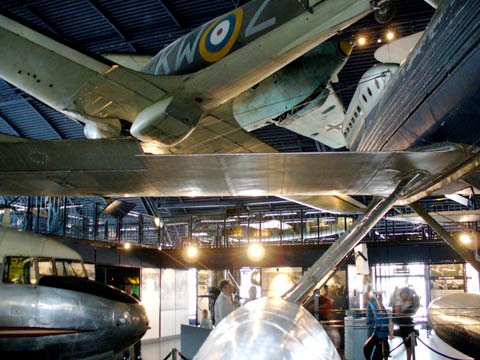
You want planes? We got planes.
After the Natural History Museum, the Science Museum, though really it should be called the Technology Museum as there's not a lot of what I would call basic science on show (perhaps due to the afore-mentioned Natural History Museum being right next door). Still, that's just nit-picking, as this is yet another truly excellent museum.
I headed straight for the space section ...

You only live twice, Mr Bond -- or sometimes not at all. The fifth and last Black Arrow launch vehicle, and the end of the British space programme (if you are measuring such things only in terms of really big rocket launchers, that is).

A scale model of the Hubble Space Telescope which was so cute I just wanted to pick it up and take it home with me. OK, so at one-fifth scale it's about the size of a small car instead of a bus, but that's what excess baggage is for, right ...
Now to the Making the Modern World gallery.
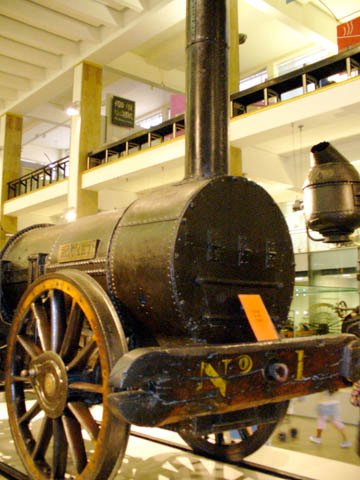
Another Rocket, Stephenson's. Seriously, wow.
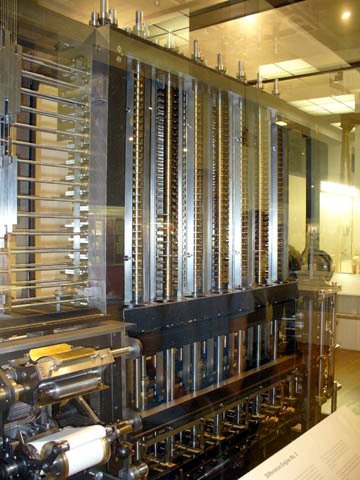
The working model of Babbage's Difference Engine No. 2. (They also have Babbage's brain in a jar but I presume it doesn't work so well any more.) It was designed in 1847-9 but not completed until 1991. It's not a Turing machine like his later Analytical Design apparently was, but this is getting close to a general purpose computer. ObSlashdot: imagine a Beowulf cluster of these ...

An example of the Avro 504, one of the most significant aircraft of the First World War era. First flown in 1913; used in the RNAS raid on the Zeppelin sheds at Friedrichshafen in 1914, as well as for home defence late in the war but mainly used as trainers. Over 8000 were built, with many ending up in civilian use after the war: QANTAS's first airliner was a 504K (total number of passengers: 2).

The Rolls-Royce "flying bedstead" (technically Thrust Measuring Rig), an experimental VTOL aircraft (well, loosely defined) from the mid-1950s.
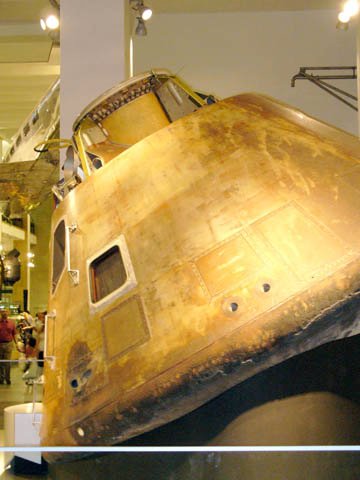
The actual Apollo 10 Command Module, which has been around the Moon and back. I was just so amazed to be in the presence of this object that I forgot to take any good pictures.
Next, I found my way to the maritime section, which had lots of models and was therefore very cool, but models in glass cases don't make for interesting photos so I'll skip onto the aviation gallery ...

A Vickers Vimy, the workhorse longrange bomber of the early RAF. I'm glad the Science Museum has one as my photos of the RAF Museum's replica didn't come out so well. Plus there's the fact that this one isn't a replica: it's the one used by Alcock and Brown to fly across the Atlantic in 1919!
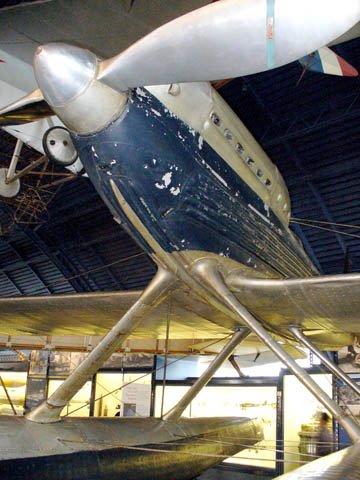
Another historic object: the Supermarine S.6B which won the Schneider Trophy for Britain in 1931 (the trophy itself is also on display and it's ludicrously big). It was designed by R. J. Mitchell, who later designed the Spitfire. I suspect the S.6B's influence on the Spitfire can be overstated, particularly when Mitchell's failed Supermarine Type 224 design of 1934 -- which was also called the Spitfire, but had gull wings, fixed undercarriage and an open cockpit -- is ignored, as it often is (I didn't see it mentioned in the Museum's own exhibit on the evolution of the Spitfire, though I might have missed it). But certainly it was an important experiment in streamlining, and it pushed aero engine development too. And it does look cool.

The Westland-Hill Pterodactyl, one of the odder aircraft to come out of the interwar British aviation industry (and a favourite at RAF Pageants). It was originally an experiment in tailless flight; later, fighter and transatlantic passenger (!) variants were proposed. This is is one of the early models, the Pterodactyl IA from 1925. (NB. its efficacy against Zeppelins is unknown.)
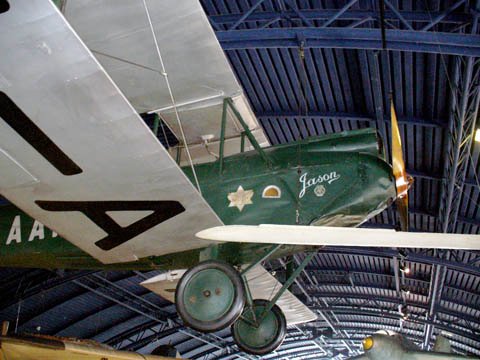
Yet another important individual aeroplane: Amy Johnson's Gipsy Moth "Jason", the one in which she flew solo from London to Darwin in 1930. It's an amazingly small and frail-looking aircraft for such a long and dangerous journey. I'm not superstitious at all, but personally I would have preferred a less ominous registration code than "G-AAAH"!
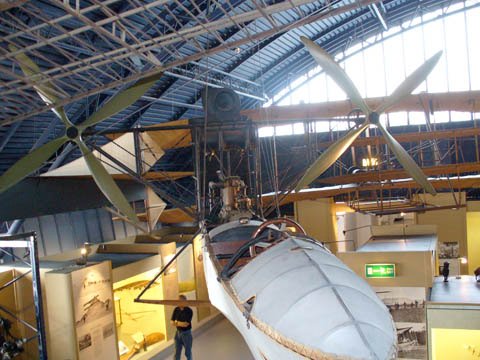
The gondola of the Beta, the first practical British military airship, built at Farnborough in 1910 and used to escort transports across the Channel early in the First World War.
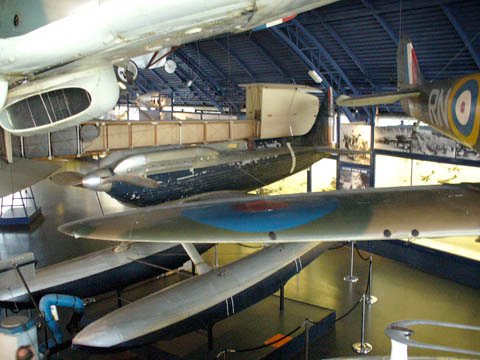
Oh, why not -- another shot of the S.6B, nestled in between the Vimy, a Hurricane and a Spitfire.
![]() This work is licensed under a Creative Commons Attribution-NonCommercial-NoDerivatives 4.0 International License.
Permissions beyond the scope of this license may be available at http://airminded.org/copyright/.
This work is licensed under a Creative Commons Attribution-NonCommercial-NoDerivatives 4.0 International License.
Permissions beyond the scope of this license may be available at http://airminded.org/copyright/.



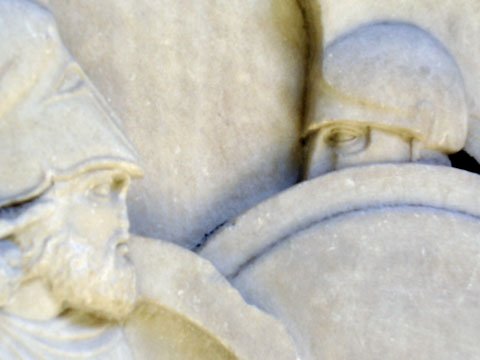

Jakob
I was told this story by one of the Science Museum old hands; I assume it's apocryphal. Supposedly the command module was supposed to be on loan from NASA, and one day a request came through for the eventual return of the module. It was pointed out in an embarassed manner that it was now one of the centrepiece objects in the shiny new expensive exhibition, and could the SciM please keep it a little longer? No more was ever said.
Like I said, probably apocryphal, especially as I've heard a version in which the module has to stay because there's no door large enough to get it out, which seems unlikely.
As for the Schneider trophy, my first thoughts on seeing it were 'they went to all that effort for *this*?'
CK
Phwoar!
Brett Holman
Post authorWell I can't argue with that.
Ricardo Reis
I think the trophy is beautiful and am surely surprised everytime I see someone difer :)
Brett Holman
Post authorFor those who haven't seen it, there's a photo of the trophy (or at least the top of it) here. It's a bit ... different ... but I quite like it!
Jakob
It is impressive, but for something that's all about celebrating speed, I find it a bit... massive. Generally I find the aesthetics of the aeroplanes superior.
Pingback:
Imagined Community
Pingback:
Airminded · Swansea